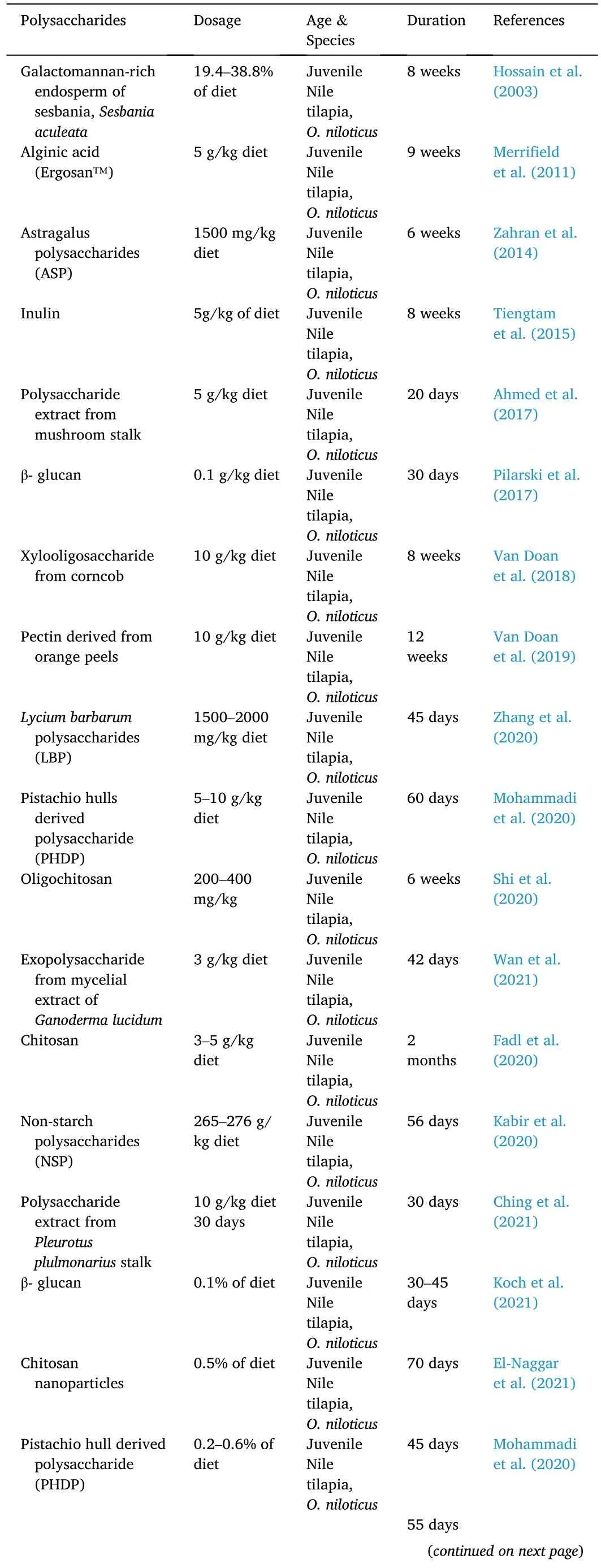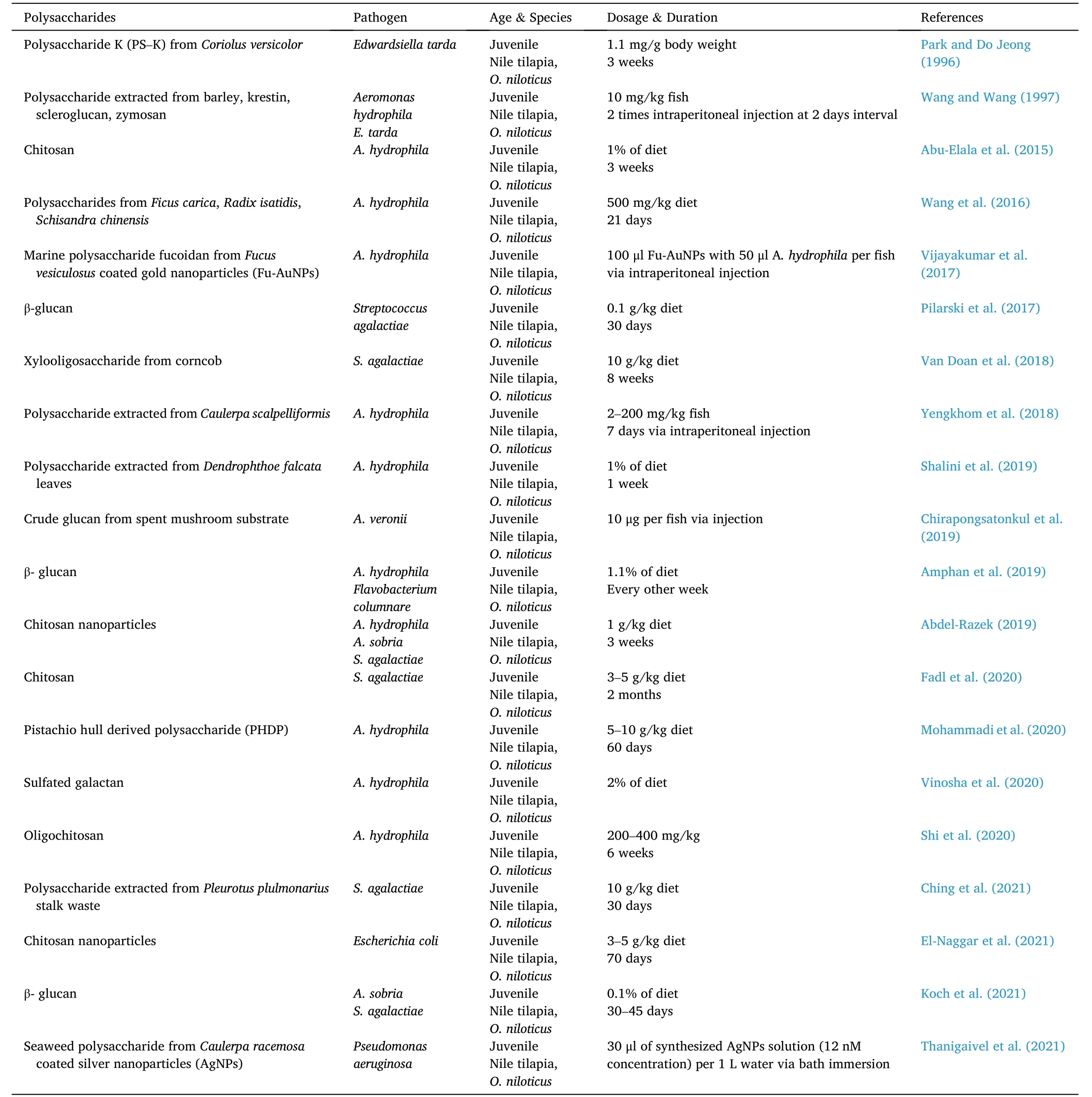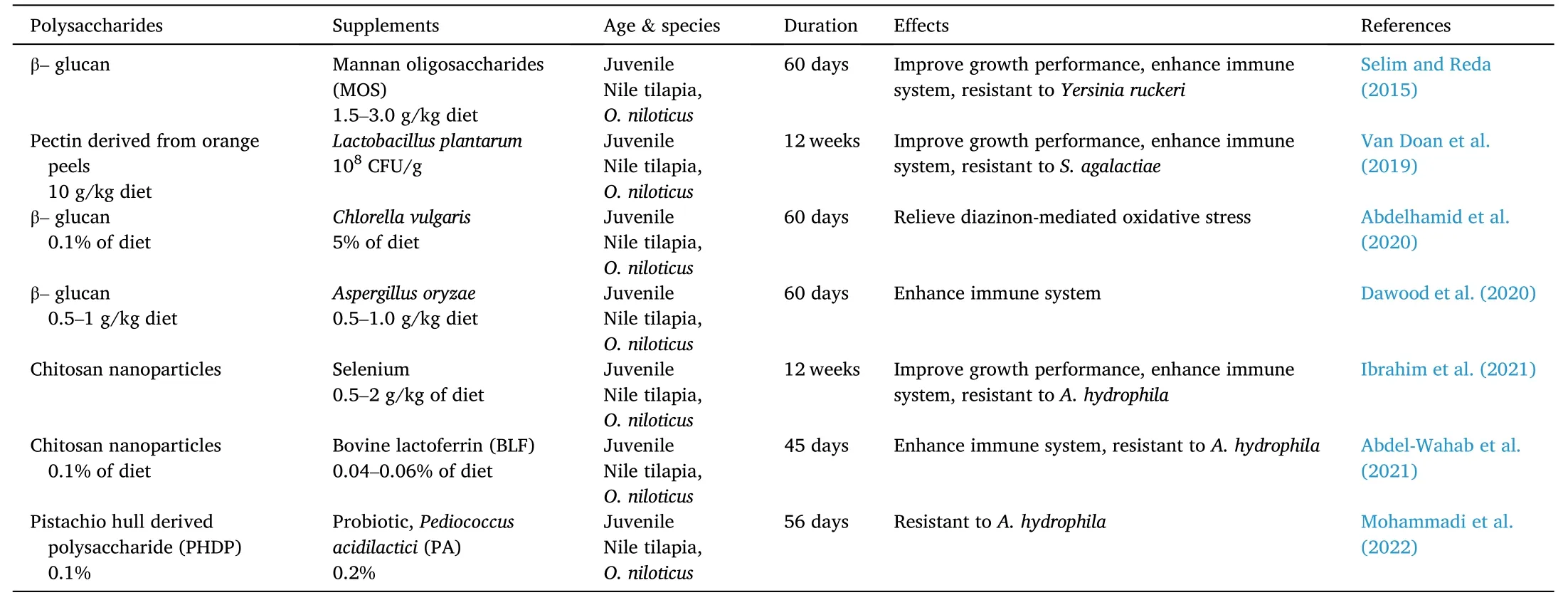The roles of polysaccharides in tilapia farming: A review
Zulhisym Abul Kri,Weny Wee,Noor Khlih Abul Hmi,Mhmou A.O.Dwoo,Nik Nur Azwni Binti Zkri,Lee Seong Wei,**
a Department of Agricultural Sciences,Faculty of Agro-Based Industry,Universiti Malaysia Kelantan,Jeli Campus,Jeli,Kelantan,17600,Malaysia
b Advanced Livestock and Aquaculture Research Group,Faculty of Agro-Based Industry,Universiti Malaysia Kelantan,Jeli Campus,Jeli,Kelantan,17600,Malaysia
c Center of Fundamental and Continuing Education,Universiti Malaysia Terengganu,Kuala Nerus,Terengganu,21030,Malaysia
d School of Biological Sciences,Universiti Sains Malaysia,Minden,Pulau Pinang,11800,Malaysia
e Animal Production Department,Faculty of Agriculture,Kafrelsheikh University,Kafr El-Sheikh,33516,Egypt
fThe Center for Applied Research on the Environment and Sustainability,The American University in Cairo,11835,Cairo,Egypt
Keywords: Aquaculture Growth performance Immune response Disease resistance Abiotic stressor Synergistic Polysaccharide
ABSTRACT Impairment of fish growth and immune system due to stress and disease are major constraints in aquaculture industry.Traditionally,antibiotic was used as prophylactic agent in the health management of aquaculture species.However,antibiotic only provide a temporary solution to the problem of disease outbreak.Over-reliance on antibiotic also has led to the increasing cases of antibiotic resistance among pathogenic bacteria from aquaculture sites and contamination of antibiotic residues into human food chain.Probiotic,prebiotic and symbiotic are therefore suggested as alternatives to prophylactic antibiotic to be used in the aquaculture industry.A potential prophylactic agent is polysaccharide that could be developed into an alternative antibiotic for aquatic animals.In this review paper,definition,sources,and mode of action of polysaccharide are presented.The roles of polysaccharides in fish farming with emphasis on growth improvement,immune system enhancement,disease resistance stimulation in tilapia farming,and the effects of polysaccharides on abiotic stressors are summarized and discussed.
1.Introduction
Tilapia is an important aquaculture species in the world.This fish was mainly farmed in Asia,Africa and America (Lee et al.,2016;Lee &Wendy,2017;Yu et al.,2022).The production of tilapia accounted for 10.2% of the total finfish production by aquaculture in 2018 (FAO,2021).China remains the top producer of tilapia with an annual production around 1.8 million tons,whereas Indonesia is the second largest tilapia producer with an annual production around 1.2 million tons(FAO,2021).This is followed by Africa and Brazil.The history of tilapia farming started in Egypt thousands of years ago and has spread throughout the world that it becomes one of the major aquaculture species in many countries.In Bangladesh,tilapia is the third important aquaculture species after pangas and rohu (Rahman et al.,2021).In Kenya,tilapia farming is the dominant aquaculture species with an annual production of 24096 metric tons or equivalent to 70% of Kenya aquaculture production (Opiyo et al.,2018).Tilapia farming provides protein source,job and income to people around the world (Naylor et al.,2021).Tilapia was also recognised as important protein source in developing countries.With advance tilapia farming system and significant market demand,tilapia production is anticipated to increase.Nevertheless,as tilapia farming intensifies,the farmed fish become stressed and prone to disease infection.Large-scale farming of tilapia has negative impacts to the fish,such as decline in immunity,increase in mortality,and has high rate of disease transmission.These issues become a stumbling block to the development of tilapia farming in the coming years.
Currently,application of immunostimulant compounds for finfish and shellfish aquaculture is of much interest (Kari et al.,2022a).Boosting the immune response of aquatic animals by administration of immunostimulant such as polysaccharide is one of the most promising strategies in managing microbial diseases in aquaculture (Dawood et al.,2018).Polysaccharides are mainly derived from plant cell walls,agricultural wastes,seaweed,and others.Some of these polysaccharides are inexpensive and commercially available.For instance,β-glucan has been widely used as immunostimulant for over 40 years (Pilarski et al.,2017).This homopolysaccharide is preferred in aquaculture for aquatic animal health management due to its availability,bioactivity and environmentally sustainable nature (Meena et al.,2013).Polysaccharides-supplemented feed enhances innate and adaptive immune response of the aquatic animals,hence resulting in increased resistance to disease infection (Harikrishnan et al.,2011).The use of plant source,seaweed polysaccharide and probiotic combination promotes growth and improves health of the aquatic animals (Kari et al.,2022a;Vidhya Hindu et al.,2019).Furthermore,application of natural product in aquatic health management is likely to gain consumer confidence on the safety of aquaculture product.In this review,current trend of polysaccharides application in tilapia farming for growth performance improvement and health management is highlighted.
2.Definition,mode of action and source of polysaccharides
Polysaccharide is a biopolymer consists of monosaccharides linked together by glycosidic linkages (Udayan et al.,2017).This simple sugar polymer can be found extensively in nature either with linear or highly branched molecular structure.There are two types of polysaccharides,namely homopolysaccharides and heteropolysaccharide.Homopolysaccharides are made of same monosaccharide units,whereas heteropolysaccharides consist of two or more different monosaccharide units (Udayan et al.,2017).This natural polymer can be derived from various sources of plant,animal and microorganism through extraction(Al-Assaf,2016).Polysaccharide can be extracted from plant cell wall like pectin,cellulose,and starch.Some polysaccharides are derived from seeds such as guar gum,bean gum and tara gum.Other polysaccharides are extracted from roots,tubers and seaweeds (Al-Assaf,2016;Ullah et al.,2019).Mode of action of a polysaccharide depends on the type of the polysaccharide itself.For example,β-glucan is a well-known polysaccharide from the cell walls of plant and yeast.This polysaccharide can reduce energy intake and increase level of antioxidant enzymes in the body (El Khoury et al.,2012).Hence,consumption of β– glucan improves growth performance and enhances immune system of a host.Other polysaccharides such as pectin (Zhang et al.,2015) and fucoidan(Wijesekara et al.,2011) that derived from seaweed show inhibitory effects on various bacteria and virus,therefore stimulate disease resistance of a host.In general,functionality of the polysaccharide,either antimicrobial,immunostimulatory,anti-stress,or growth promoter,are determined by different bioactive compounds of the polysaccharides.Polysaccharide has been claimed as prebiotic to boost gut microbiome that lead to improve growth performance,activate innate immunity,enhance disease resistance and mitigate abiotic stressors of farmed tilapia (reference required).
3.Polysaccharides improve growth performance of farmed tilapia
Effectiveness of polysaccharide in improving growth performance of tilapia was first documented by Hossain et al.(2003) as shown in Table 1.In the study,polysaccharide extracted from the seed of sesbania(Sesbania aculeata) was supplemented in the feed formulation for tilapia,up to 38.8% to alternate conventional ingredients such as fish meal and soy meal.The supplemented polysaccharide supports the growth of tilapia.This suggests that polysaccharide can be a better option for energy provider compared to simple sugar,as explained in the study of Zhou et al.(2021).The study found that feeding polysaccharide to tilapia improved health and liver protection compared to feeding simple sugars such as glucose and sucrose,which can cause glucose metabolism disorder.Non-starch polysaccharides (NSP) is one type of polysaccharide that is digested by tilapia but under-utilized for growth(Haidar et al.,2016).In tilapia farming pond,NSP was discovered to increase the production of natural food (Kabir et al.,2020).The availability of natural food indirectly reduces the operational cost of feed in tilapia farming and contribute to the increase in fish production (Kari et al.,2020,2021,2022b).

Table 1 Polysaccharides that improve growth performance of tilapia.
Examples of commercially available polysaccharides for tilapia farming are β-glucan (Koch et al.,2021;Pilarski et al.,2017) and inulin(Tiengtam et al.,2015).However,not all commercial polysaccharides are effective in promoting growth of tilapia.Merrifield et al.(2011)reported that juvenile tilapia which received diet supplemented with 5 g/kg diet of commercial alginic acid (Ergosan™) for 9 weeks had no significant difference in terms of growth performance and gut microbiota of the fish.Other study by Shiau and Yu (1999) claimed that growth performance of Nile tilapia was negatively affected when the diet was supplemented with 2–10% chitin and chitosan for 8 weeks.However,recent studies by Fadl et al.(2020) and El-Naggar et al.(2021)claimed that chitosan with similar range of doses performed significantly better in growth performance of tilapia.Discrepancy in the results may,in part,due to technical errors and other aspects related to fish handling in evaluating the efficacy of chitosan.These inconsistent results may be due to the size,species,and feed composition of tilapia.
Polysaccharide from medicinal herb is also found to improve the growth of farmed tilapia.For example,Lycium barbarumfruit or commercially known as goji berry under Chinese medicinal herb,has been extensively utilized for thousands of years.The bioactive compound in the fruit is known asL.barbarumpolysaccharide (LBP) (Tian et al.,2019).This medicinal herb polysaccharide was reported to improve growth in tilapia farming based on the studies by Zhang et al.(2021) and Zhang et al.(2020).Agricultural wastes such as mushroom stalk (Ahmed et al.,2017),corncob (Van Doan et al.,2018),orange peel(Van Doan et al.,2019),pistachio hull (Mohammadi et al.,2020) andPleurotus pulmonariusstalk (Ching et al.,2021) contributed to the supply of polysaccharides in improving tilapia growth performance as well.However,further study may need to be carry out to identify the bioactive compounds in the agricultural wastes and their mode of action to better understand their functions in tilapia farming.
4.Polysaccharides activate the innate immunity of farmed tilapia
Polysaccharides such as glucan,mannan and pectin are extensively studied for their immunomodulatory property.The presence of acetyl and sulphate groups are responsible for immunostimulant activity of the polysaccharides (Ferreira et al.,2015).β-glucan is a commercial polysaccharide widely used in the maintenance of human and animal health.Many studies have indicated that β-glucan can enhance immune system of tilapia,such as Pilarski et al.(2017),Yamamoto et al.(2018),Amphan et al.(2019) and Koch et al.(2021) (Table 2).The administration of β-glucan in tilapia farming was suggested at 0.1% of diet with duration ranging from 30 days to 45 days.However,Amphan et al.(2019) claimed that application of β-glucan every other week was also effective to enhance the immune system of tilapia yet cost effective.Besides,it was discovered that β-glucan derived from mushroom(Ganoderma lucidum) has wound healing activity in tilapia and possess liver protection property throughin vitrostudy (Hsiao et al.,2016).
Most of the polysaccharides used in enhancing tilapia immune system are derived from agricultural wastes such as corncob,spent mushroom substrate,orange peel,pistachio hull andPleurotus plulmonariusstalk waste.Other sources of polysaccharides that could be employed asimmunostimulant for tilapia farming are medicinal herbs such asAstragalus,Ficus carica,Radix isatidis,Schisandra chinensis,Dendrophthoe falcata,Ganoderma lucidumandLycium barbarum.Lycium barbarumpolysaccharide (LBP) was found to improve growth performance (Mo et al.,2016) and non-specific immune (Zhu et al.,2020).LBP also served as prebiotic to promote growth of probioticsLactobacillus acidophilusandBifidobacterium longum.At the same time,LBP enhances beneficial gut microbiota such asAkkermansia,LactobacillusandPrevotellaceae(Zhu et al.,2020).
Overall,polysaccharides derived from agricultural wastes and medicinal herbs have shown promising results in modulating the tilapia immune system,but they are not economically wise at present.Therefore,β-glucan is still the most abundant,effective,and economical polysaccharide to be utilized in tilapia farming.
5.Polysaccharides enhance health of farmed tilapia against diseases
Beneficial feed additives such as polysaccharides have been reported to maintain fish intestinal health,improve digestion,and enhance immunity of fish (Dawood,2021).Based on literature survey,commercial polysaccharides,polysaccharides embedded nanoparticles,and polysaccharides derived from agricultural wastes,medicinal herbs and seaweeds were used in tilapia farming against diseases (Table 3).β-glucan and chitosan are two commercial polysaccharides that have been reported to stimulate disease resistance of tilapia effectively againstAeromonas hydrophila(Abu-Elala et al.,2015),Streptococcus agalactiae(Fadl et al.,2020;Pilarski et al.,2017),Flavobacterium columnare(Amphan et al.,2019) andAeromonas sobria(Koch et al.,2021).These two polysaccharides are inexpensive and abundant,hence can be used extensively in tilapia farming health management.Furthermore,practical dosage and administration method of these two polysaccharides are established and well reported.β-1,3-glucan paramylon (Algamune™)incorporated into feed may not enhance disease resistance of Nile tilapia toStreptococcus iniaesignificantly,but it reduced the mortality of the fish(Yamamoto et al.,2018).

Table 3 Polysaccharides that enhance health of farmed tilapia against diseases.
Recent studies claimed that polysaccharides embedded nanoparticles showed promising results in stimulating disease resistance of tilapia againstAeromonas hydrophila(Vijayakumar et al.,2017),Aeromonas sobria,Streptococcus agalactiae(Abdel-Razek,2019),Escherichia coli(El-Naggar et al.,2021) andPseudomonas aeruginosa(Thanigaivel et al.,2021).Notwithstanding,nanoparticle approach is not cost-effective for current tilapia farming.Agricultural wastes such as corncob (Van Doan et al.,2018),spent mushroom substrate (Chirapongsatonkul et al.,2019),pistachio hull (Mohammadi et al.,2020)andPleurotus plulmonariusstalk waste (Ching et al.,2021) possessed polysaccharides that can enhance disease resistance of tilapia against various bacterial pathogen,mainly theAeromonas hydrophila,A.veroniiandStreptococcus agalactiae.While most of these studies focus on bacterial diseases,there is a need to expand research into viral,fungal,and parasitic diseases which could lead to significant economic loss when outbreaks in tilapia farming.
Polysaccharides derived from medicinal herbs and seaweeds also exhibited encouraging findings in stimulating disease resistance of tilapia to various diseases.Polysaccharides derived fromFicus carica,Radix isatidisandSchisandra chinensiswere found to be capable of protecting tilapia fromA.hydrophilainfection in the study by Wang et al.(2016),whereas polysaccharide fromCoriolus versicolorprotect tilapia fromEdwardsiella tardainfection (Park &Do Jeong,1996).The polysaccharides from seaweed were administrated to tilapiaviaintraperitoneal injection or immersion rather than feed supplemented,according to studies by Vijayakumar et al.(2017),Yengkhom et al.(2018) and Thanigaivel et al.(2021).Even though the polysaccharides from seaweed stimulates disease resistance of tilapia against bacterial diseases,intraperitoneal injection method can be laborious,while immersion method is relatively impractical,except for small sized fish.
6.Effects of polysaccharides on abiotic stressors in tilapia farming
Tilapia farming is an important aquaculture activity in many countries,especially in Asia.As the demand for seafood surges,the aquaculture industry is gearing up to produce more cost-effective aquaculture species (Das et al.,2017).However,high stocking density in an aquaculture system may cause aquaculture species to be under stress.Abiotic stressors in an aquaculture system includes the fluctuations of pH,low oxygen,or temperature.Other stress factors to aquaculture species may come from water source pollution with insecticide (Abd El Hakim et al.,2019),pesticide (Elbahnaswy et al.,2021),heavy metals(Salaah et al.,2022),and from contaminated fish feed (Abdel-Daim et al.,2020) that may end up in undesirable fish mortality.Recent studies demonstrated that polysaccharides delivered to farmed tilapia noticeably has alleviated stress in the fish (Table 4).According to Ahmed et al.(2017),polysaccharide extract from mushroom stalk was able to mitigate pH-induced stress in Nile tilapia (Oreochromis niloticus).Similarly,commercial polysaccharides such as β-glucan and chitosan are useful in reducing stress due to abiotic factors in tilapia farming.β-glucan not only reduce the stress in tilapia exposed to insecticide,but also allow tilapia to survive under low level of oxygen.Chitosan and chitosan embedded nanoparticles reduce the detrimental effect of heavy metals and insecticides in tilapia farming (Elbahnaswy et al.,2021;Salaah et al.,2022).Inulin,a polysaccharide was also reported able to mitigate high salinity of Nile tilapia farming environment as described by Zhou et al.(2020).Besides,dietary polysaccharide derived from medicinal herb,Astragalus membranaceus(ASP) was reported to modulate the oxidative stress induced by thallium,a highly toxic heavy metal(Farag et al.,2021).Fucoidan,a polysaccharide derived from seaweed,was found to be capable of eliciting protective activity in the Nile tilapia against toxicity from aflatoxin B1(Abdel-Daim et al.,2020).Overall,ameliorative roles by the polysaccharides on abiotic stress in tilapia farming are highly valued to increase the fish production.

Table 4 Application of polysaccharides and the associated abiotic stressors in tilapia farming.
7.Effects of polysaccharide complex in tilapia farming
Recent studies demonstrated that polysaccharide complex,or combination of polysaccharide with other prophylactic agent,have remarkable prospects in the sustainable production of tilapia (Table 5).Combination of β-glucan and mannan oligosaccharides (MOS) can improve growth performance,enhance immune system,and stimulate disease resistant of tilapia toYersinia ruckeri.These two biopolymers are inexpensive and abundant in the market for immediate application in tilapia farming (Selim &Reda,2015).In order to mitigate the toxicity effects of insecticide diazinon (Abdelhamid et al.,2020) and to enhance immunity of tilapia (Dawood et al.,2020),combination of β-glucan with respective microalgae (Chlorella vulgaris) and yeast (Aspergillus oryzae)were used.Polysaccharides derived from agricultural wastes such as orange peel (Van Doan et al.,2019) and pistachio hull (Mohammadi et al.,2020) have been working effectively with probiotics,specificallyLactobacillus plantarumandPediococcus acidilactici,to improve growth performance,enhance immune system and resistance to diseases.Likewise,polysaccharide embedded nanoparticle with selenium and bovine lactoferrin increased tilapia resistance toA.hydrophila,besides enhancement on growth performance and immunity (Abdel-Wahab et al.,2021;Dawood et al.,2021;Ibrahim et al.,2021).Hence,the recent studies suggest that polysaccharides work synergically with other supplements in tilapia farming for better production.

Table 5 Effects of combined polysaccharides and supplements in tilapia farming.
8.Conclusion and recommendation
Polysaccharide has been a trending biopolymer for aquaculture feed due to their beneficial impacts on growth performance,immunity,disease resistance and stress tolerance.This biopolymer can be found naturally from plant,medicinal herb,seaweed,and agricultural wastes,in which the bioactive compounds contribute to antimicrobial,antioxidant,and immunomodulatory activities.Application of polysaccharides and their combinations from various sources demonstrate its great potential to be used in tilapia farming.In particular,polysaccharides such as β-glucan and chitosan are primarily abundant and inexpensive to increase the production of tilapia farming.However,the use of other bioactive polysaccharides faces challenge due to the constraints of cost and availability in commercial scale.In order to establish common utilization of these polysaccharides in aquaculture,it is recommended to perform further research on the development of extraction and synthesis technology for larger scale production of the polysaccharides.
Data availability statement
Not applicable.
CRediT authorship contribution statement
Zulhisyam Abdul Kari:Writing– original draft,Writing– review &editing.Wendy Wee:Conceptualization,Writing– review &editing.
Noor Khalidah Abdul Hamid:Writing– review &editing.Mahmoud A.O.Dawood:Supervision,Conceptualization,Writing– original draft,Writing– review &editing.Nik Nur Azwanida Binti Zakaria:Writing–original draft,Writing– review &editing.Lee Seong Wei:Project administration,Writing– original draft,Writing– review &editing.
Declaration of competing interest
The authors declare no conflict of interest.
 Aquaculture and Fisheries2024年1期
Aquaculture and Fisheries2024年1期
- Aquaculture and Fisheries的其它文章
- Editorial special issue: Friendly nutritional strategies for sustainable aquaculture
- Hematobiochemical and histopathological alterations in Nile Tilapia(Oreochromis niloticus) exposed to ethidium bromide: The protective role of Spirulina platensis
- Effects of Moringa oleifera aqueous extract on the growth performance,blood characteristics,and histological features of gills and livers in Nile tilapia
- Evaluation of the nutritional value of Artemia nauplii for European seabass(Dicentrarchus labrax L.) larvae
- Antioxidant effects of the aqueous extract of turmeric against hydrogen peroxide-induced oxidative stress in spotted seabass (Lateolabrax maculatus)
- Marine yeast Rhodotorula paludigena VA 242 a pigment enhancing feed additive for the Ornamental Fish Koi Carp
